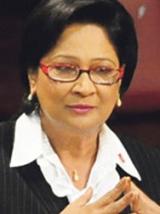By Caribbean Medical News Staff
CARICOM Heads of Government met in a special session to address the issues of Ebola and chikungunya in the region and a specific regional response to the disease. Months ago, Prime Minister of Trinidad & Tobago Kamla Persad-Bissessar had asked that CARICOM meet to discuss a rapid regional response to the deadly Ebola Virus Disease (EVD) and the rapidly spreading and out of control chikungunya outbreak.
The response by the Caribbean Community is being coordinated by the Trinidad-based Caribbean Public Health Agency (CARPHA).
CARICOM heads suggested that while there have been no cases of Ebola suspected or confirmed in the region and given that risk is low to the region, CARICOM heads have determined that it is possible that an Ebola case could slip through and enter the region by way of travel and said that the region must build capacity to address and future public health issue.
Ten point plan adopted
The participants also acknowledged the work PAHO, CARPHA, the OECS Secretariat and the Government of Cuba to strengthen capacity to address Ebola.
The ten point plan agreed upon by CARICOM is as follows:
1. strengthen effective, coordinated measures at ports of entry to prevent Ebola from entering the Community, including harmonising travel restrictions;
2. strengthen health systems including training, equipment, laboratories and containment, and enlist the participation of airlines in the region in transporting specimens and response teams;
3. create a regional rapid response team (Carib REACT) able to reach any member state in 24 hours to support the national response team to contain/stop an outbreak early on;
4. Launch an intensive public education campaign for citizens of the region, visitors and those outside;
5. organize a comprehensive resource mobilisation effort including a possible Stop Ebola There and Here (SETH) Fund, to which governments, citizens and businesses here and abroad may donate;
6. Finalise and implement the harmonised regional operational response plan by end-November, coordinated with national response plans;
7. Participate in capacity-building efforts at the global and regional levels to gain experience for regional benefit;
8. Establish a regional coordinating mechanism on Ebola (RCME) with CARPHA as chair, including the CARICOM and OECS Secretariats, IMPACS, CDEMA, and inviting Cuba to participate. The RCME will report to the lead head of government on health, Dr Denzil Douglas, prime minister of St Kitts and Nevis, with the immediate responsibility to develop a comprehensive regional strategy to address Ebola preparedness in collaboration with PAHO/WHO;
9. invite PAHO/WHO, the United Nations, other development partners and contributors to a meeting within one month to expand the effectiveness of the collective response;
10. review and reinforce the effectiveness of these measures as implemented, at the inter-sessional meeting of Conference in February 2015, and again at the regular meeting of the Conference of Heads of Government in July 2015;
The heads of government agreed that responsibilities need to be clear and assessed based on the core competencies of various organizations. However, the meeting mandated that CARPHA in collaboration with PAHO/WHO and other international stakeholders and interested parties needed to develop a more comprehensive inventory of the requirements in capacity and other response requirements so that the region knows precisely what is required to fight the deadly disease.
Regarding CARICOM’s response to chikungunya, the regional Heads acknowledged that CARPHA’s prediction that chikungunya had reached epidemic proportions in the Caribbean.
Chikungunya
Chikungunya continues to rage through the Caribbean with the spread of the disease being reported in 23 of 24 CARICOM member-states with the spread calculated by CARPHA to be one country reporting infection every week.
Despite efforts by the Ministries of Health and government officials in CARICOM island-countries and despite partnerships with the US CDC, PAHO/WHO along with other stakeholders, chikungunya has reached epidemic levels in the Caribbean. To this end, the CARICOM meet has adopted and decided to accept the following to address the disease which while invariably not fatal, is sickening hundreds in the Caribbean. In some cases, people are self-diagnosing as well.
CARICOM says that::
1. that there must be a multi-sectoral approach to fighting the disease that would include education, tourism, media, local government and other sectors and capabilities, including private enterprises, and explore the use of new technologies
2. That there must be a well-coordinated, continuous public education campaign on how the disease is spread, targeting the citizenry, travellers, and tourism stakeholders
3. The strengthening of vector control response capacity
4. the facilitation by PAHO/WHO of bulk purchase of essential public health supplies, such as bed nets, insecticides and repellent
During their discussions, the heads of Government also suggested that a Caribbean Mosquito Awareness Week be established on an annual level in partnership with CARPHA, PAHO/WHO and other stakeholders with a view to educating the public on vector control and other public awareness strategies to control the spread of Dengue and chikungunya in the region














